Yiming Zhao
Comparison Research of Millimeter-Wave/Infrared Co-aperture Reflector Antenna Systems Based on a Specialized Film
Apr 27, 2025Abstract:This paper presents a novel co-aperture reflector antenna operating in millimeter-wave (MMW) and infrared (IR) for cloud detection radar. The proposed design combines a back-fed dual-reflector antenna, an IR optical reflection system, and a specialize thin film with IR-reflective/MMW-transmissive properties. Simulations demonstrate a gain exceeding 50 dBi within 94 GHz plush or minus 500 MHz bandwidth, with 0.46{\deg} beamwidth in both azimuth (E-plane) and elevation (H-plane) and sidelobe levels below -25 dB. This co-aperture architecture addresses the limitations of standalone MMW and IR radars, enabling high-resolution cloud microphysical parameter retrieval while minimizing system footprint. The design lays a foundation for airborne/spaceborne multi-mode detection systems.
SDVPT: Semantic-Driven Visual Prompt Tuning for Open-World Object Counting
Apr 24, 2025



Abstract:Open-world object counting leverages the robust text-image alignment of pre-trained vision-language models (VLMs) to enable counting of arbitrary categories in images specified by textual queries. However, widely adopted naive fine-tuning strategies concentrate exclusively on text-image consistency for categories contained in training, which leads to limited generalizability for unseen categories. In this work, we propose a plug-and-play Semantic-Driven Visual Prompt Tuning framework (SDVPT) that transfers knowledge from the training set to unseen categories with minimal overhead in parameters and inference time. First, we introduce a two-stage visual prompt learning strategy composed of Category-Specific Prompt Initialization (CSPI) and Topology-Guided Prompt Refinement (TGPR). The CSPI generates category-specific visual prompts, and then TGPR distills latent structural patterns from the VLM's text encoder to refine these prompts. During inference, we dynamically synthesize the visual prompts for unseen categories based on the semantic correlation between unseen and training categories, facilitating robust text-image alignment for unseen categories. Extensive experiments integrating SDVPT with all available open-world object counting models demonstrate its effectiveness and adaptability across three widely used datasets: FSC-147, CARPK, and PUCPR+.
VCR-Bench: A Comprehensive Evaluation Framework for Video Chain-of-Thought Reasoning
Apr 10, 2025Abstract:The advancement of Chain-of-Thought (CoT) reasoning has significantly enhanced the capabilities of large language models (LLMs) and large vision-language models (LVLMs). However, a rigorous evaluation framework for video CoT reasoning remains absent. Current video benchmarks fail to adequately assess the reasoning process and expose whether failures stem from deficiencies in perception or reasoning capabilities. Therefore, we introduce VCR-Bench, a novel benchmark designed to comprehensively evaluate LVLMs' Video Chain-of-Thought Reasoning capabilities. VCR-Bench comprises 859 videos spanning a variety of video content and durations, along with 1,034 high-quality question-answer pairs. Each pair is manually annotated with a stepwise CoT rationale, where every step is tagged to indicate its association with the perception or reasoning capabilities. Furthermore, we design seven distinct task dimensions and propose the CoT score to assess the entire CoT process based on the stepwise tagged CoT rationals. Extensive experiments on VCR-Bench highlight substantial limitations in current LVLMs. Even the top-performing model, o1, only achieves a 62.8% CoT score and an 56.7% accuracy, while most models score below 40%. Experiments show most models score lower on perception than reasoning steps, revealing LVLMs' key bottleneck in temporal-spatial information processing for complex video reasoning. A robust positive correlation between the CoT score and accuracy confirms the validity of our evaluation framework and underscores the critical role of CoT reasoning in solving complex video reasoning tasks. We hope VCR-Bench to serve as a standardized evaluation framework and expose the actual drawbacks in complex video reasoning task.
ART: Anonymous Region Transformer for Variable Multi-Layer Transparent Image Generation
Feb 25, 2025Abstract:Multi-layer image generation is a fundamental task that enables users to isolate, select, and edit specific image layers, thereby revolutionizing interactions with generative models. In this paper, we introduce the Anonymous Region Transformer (ART), which facilitates the direct generation of variable multi-layer transparent images based on a global text prompt and an anonymous region layout. Inspired by Schema theory suggests that knowledge is organized in frameworks (schemas) that enable people to interpret and learn from new information by linking it to prior knowledge.}, this anonymous region layout allows the generative model to autonomously determine which set of visual tokens should align with which text tokens, which is in contrast to the previously dominant semantic layout for the image generation task. In addition, the layer-wise region crop mechanism, which only selects the visual tokens belonging to each anonymous region, significantly reduces attention computation costs and enables the efficient generation of images with numerous distinct layers (e.g., 50+). When compared to the full attention approach, our method is over 12 times faster and exhibits fewer layer conflicts. Furthermore, we propose a high-quality multi-layer transparent image autoencoder that supports the direct encoding and decoding of the transparency of variable multi-layer images in a joint manner. By enabling precise control and scalable layer generation, ART establishes a new paradigm for interactive content creation.
Optimization-free Smooth Control Barrier Function for Polygonal Collision Avoidance
Feb 22, 2025Abstract:Polygonal collision avoidance (PCA) is short for the problem of collision avoidance between two polygons (i.e., polytopes in planar) that own their dynamic equations. This problem suffers the inherent difficulty in dealing with non-smooth boundaries and recently optimization-defined metrics, such as signed distance field (SDF) and its variants, have been proposed as control barrier functions (CBFs) to tackle PCA problems. In contrast, we propose an optimization-free smooth CBF method in this paper, which is computationally efficient and proved to be nonconservative. It is achieved by three main steps: a lower bound of SDF is expressed as a nested Boolean logic composition first, then its smooth approximation is established by applying the latest log-sum-exp method, after which a specified CBF-based safety filter is proposed to address this class of problems. To illustrate its wide applications, the optimization-free smooth CBF method is extended to solve distributed collision avoidance of two underactuated nonholonomic vehicles and drive an underactuated container crane to avoid a moving obstacle respectively, for which numerical simulations are also performed.
Neural-Polyptych: Content Controllable Painting Recreation for Diverse Genres
Sep 29, 2024
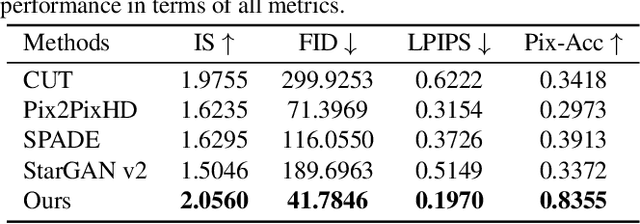


Abstract:To bridge the gap between artists and non-specialists, we present a unified framework, Neural-Polyptych, to facilitate the creation of expansive, high-resolution paintings by seamlessly incorporating interactive hand-drawn sketches with fragments from original paintings. We have designed a multi-scale GAN-based architecture to decompose the generation process into two parts, each responsible for identifying global and local features. To enhance the fidelity of semantic details generated from users' sketched outlines, we introduce a Correspondence Attention module utilizing our Reference Bank strategy. This ensures the creation of high-quality, intricately detailed elements within the artwork. The final result is achieved by carefully blending these local elements while preserving coherent global consistency. Consequently, this methodology enables the production of digital paintings at megapixel scale, accommodating diverse artistic expressions and enabling users to recreate content in a controlled manner. We validate our approach to diverse genres of both Eastern and Western paintings. Applications such as large painting extension, texture shuffling, genre switching, mural art restoration, and recomposition can be successfully based on our framework.
Perception Compressor:A training-free prompt compression method in long context scenarios
Sep 28, 2024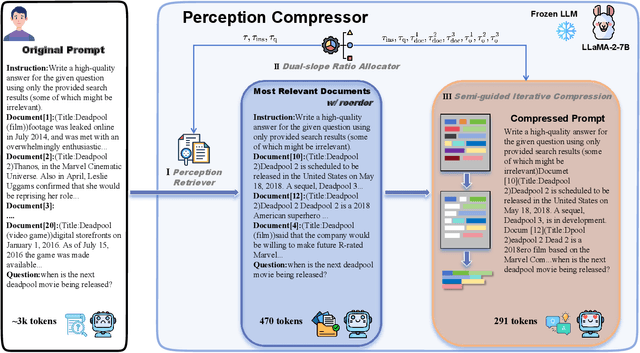

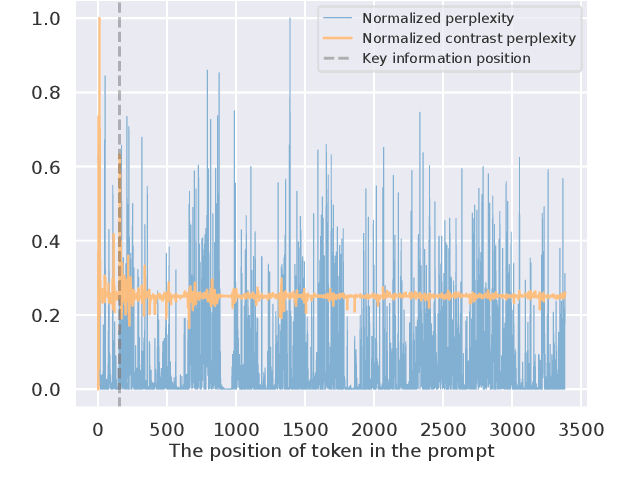
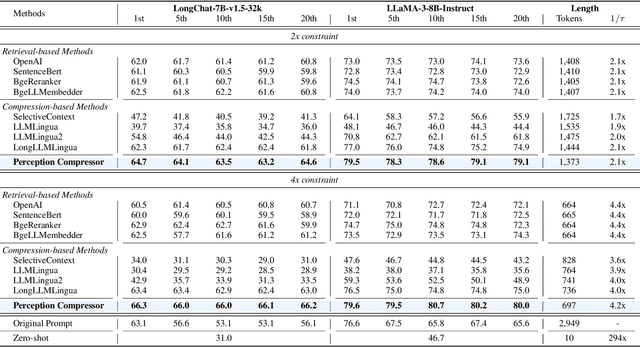
Abstract:Large Language Models (LLMs) demonstrate exceptional capabilities in various scenarios. However, they suffer from much redundant information and tend to be lost in the middle in long context scenarios, leading to inferior performance. To address these challenges, we present Perception Compressor, a training-free prompt compression method. It includes a dual-slope ratio allocator to dynamically assign compression ratios and open-book ratios, a perception retriever that leverages guiding questions and instruction to retrieve the most relevant demonstrations, and a semi-guided iterative compression that retains key information at the token level while removing tokens that distract the LLM. We conduct extensive experiments on long context benchmarks, i.e., NaturalQuestions, LongBench, and MuSiQue. Experiment results show that Perception Compressor outperforms existing methods by a large margin, achieving state-of-the-art performance.
EgoPressure: A Dataset for Hand Pressure and Pose Estimation in Egocentric Vision
Sep 03, 2024



Abstract:Estimating touch contact and pressure in egocentric vision is a central task for downstream applications in Augmented Reality, Virtual Reality, as well as many robotic applications, because it provides precise physical insights into hand-object interaction and object manipulation. However, existing contact pressure datasets lack egocentric views and hand poses, which are essential for accurate estimation during in-situ operation, both for AR/VR interaction and robotic manipulation. In this paper, we introduce EgoPressure,a novel dataset of touch contact and pressure interaction from an egocentric perspective, complemented with hand pose meshes and fine-grained pressure intensities for each contact. The hand poses in our dataset are optimized using our proposed multi-view sequence-based method that processes footage from our capture rig of 8 accurately calibrated RGBD cameras. EgoPressure comprises 5.0 hours of touch contact and pressure interaction from 21 participants captured by a moving egocentric camera and 7 stationary Kinect cameras, which provided RGB images and depth maps at 30 Hz. In addition, we provide baselines for estimating pressure with different modalities, which will enable future developments and benchmarking on the dataset. Overall, we demonstrate that pressure and hand poses are complementary, which supports our intention to better facilitate the physical understanding of hand-object interactions in AR/VR and robotics research.
Pano2Room: Novel View Synthesis from a Single Indoor Panorama
Aug 21, 2024
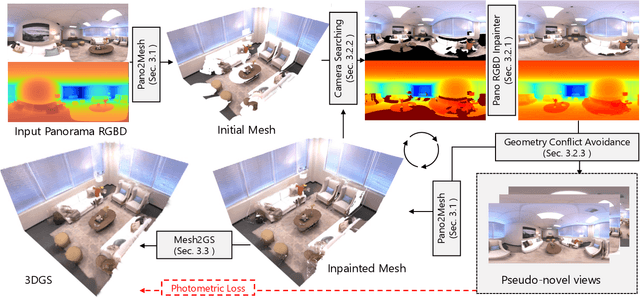
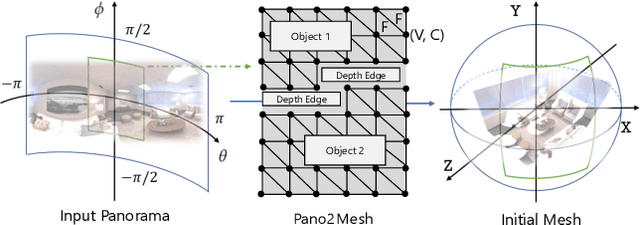

Abstract:Recent single-view 3D generative methods have made significant advancements by leveraging knowledge distilled from extensive 3D object datasets. However, challenges persist in the synthesis of 3D scenes from a single view, primarily due to the complexity of real-world environments and the limited availability of high-quality prior resources. In this paper, we introduce a novel approach called Pano2Room, designed to automatically reconstruct high-quality 3D indoor scenes from a single panoramic image. These panoramic images can be easily generated using a panoramic RGBD inpainter from captures at a single location with any camera. The key idea is to initially construct a preliminary mesh from the input panorama, and iteratively refine this mesh using a panoramic RGBD inpainter while collecting photo-realistic 3D-consistent pseudo novel views. Finally, the refined mesh is converted into a 3D Gaussian Splatting field and trained with the collected pseudo novel views. This pipeline enables the reconstruction of real-world 3D scenes, even in the presence of large occlusions, and facilitates the synthesis of photo-realistic novel views with detailed geometry. Extensive qualitative and quantitative experiments have been conducted to validate the superiority of our method in single-panorama indoor novel synthesis compared to the state-of-the-art. Our code and data are available at \url{https://github.com/TrickyGo/Pano2Room}.
Glyph-ByT5-v2: A Strong Aesthetic Baseline for Accurate Multilingual Visual Text Rendering
Jun 14, 2024



Abstract:Recently, Glyph-ByT5 has achieved highly accurate visual text rendering performance in graphic design images. However, it still focuses solely on English and performs relatively poorly in terms of visual appeal. In this work, we address these two fundamental limitations by presenting Glyph-ByT5-v2 and Glyph-SDXL-v2, which not only support accurate visual text rendering for 10 different languages but also achieve much better aesthetic quality. To achieve this, we make the following contributions: (i) creating a high-quality multilingual glyph-text and graphic design dataset consisting of more than 1 million glyph-text pairs and 10 million graphic design image-text pairs covering nine other languages, (ii) building a multilingual visual paragraph benchmark consisting of 1,000 prompts, with 100 for each language, to assess multilingual visual spelling accuracy, and (iii) leveraging the latest step-aware preference learning approach to enhance the visual aesthetic quality. With the combination of these techniques, we deliver a powerful customized multilingual text encoder, Glyph-ByT5-v2, and a strong aesthetic graphic generation model, Glyph-SDXL-v2, that can support accurate spelling in 10 different languages. We perceive our work as a significant advancement, considering that the latest DALL-E3 and Ideogram 1.0 still struggle with the multilingual visual text rendering task.
 Add to Chrome
Add to Chrome Add to Firefox
Add to Firefox Add to Edge
Add to Edge